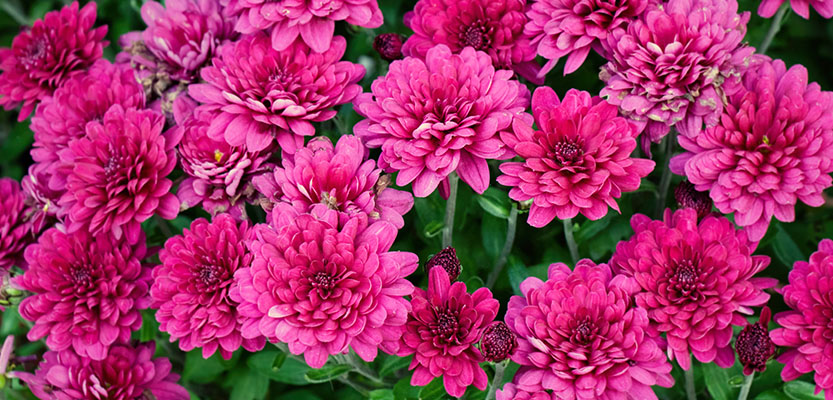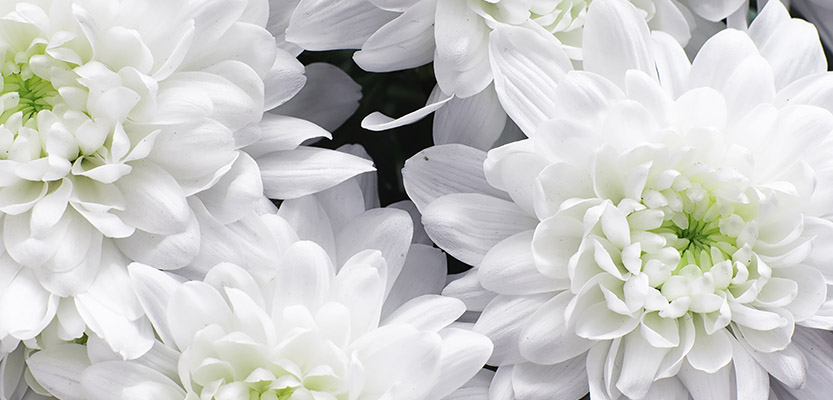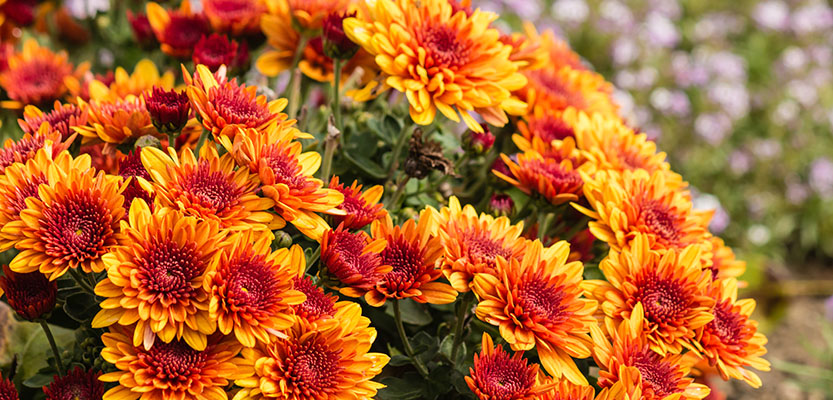Common Names:
- Chrysanthemum
- Mum
- Chrysanth
- Florist’s Daisy
Scientific Name:
- Chrysanthemum spp.
Family & Genus:
- Family: Asteraceae
- Genus: Chrysanthemum
Description:

Chrysanthemums, often referred to as "mums," are iconic for their vibrant, multi-petaled blooms that come in diverse shapes, sizes, and colors. Flowers can range from simple daisy-like forms to intricate pom-poms or spider shapes. They are available in virtually every color except blue, with popular shades including yellow, red, white, pink, purple, and green. Chrysanthemums grow on bushy plants with dark green, lobed leaves, and their blooms can vary from a few inches to several inches across depending on the variety.
Habitat & Origin:
Native to Asia, particularly China and Japan, and northeastern Europe, Chrysanthemums have been cultivated for thousands of years. They thrive in temperate climates with well-drained soil and full sun. Chrysanthemums are often grown as garden plants, in pots, or for cut flower production.
Symbolism & Meaning:
- Longevity and Immortality: In Chinese and Japanese cultures, Chrysanthemums symbolize longevity and rejuvenation.
- Cheerfulness and Optimism: Their bright colors and abundant blooms convey happiness and hope.
- Grief and Death: In European cultures, they are often associated with remembrance and are used in funerals and cemeteries.
- Nobility and Honor: Historically, Chrysanthemums were associated with royalty in Asia.
- Birth Flower of November: Chrysanthemums symbolize love and friendship for those born in November.
Uses:
- Ornamental: Widely used in gardens, floral displays, and container planting for their colorful and long-lasting blooms.
- Cut Flowers: Chrysanthemums are among the most popular flowers for bouquets due to their diversity and vase life.
- Culinary: In China, certain types of Chrysanthemum petals are used in teas and as garnishes.
- Medicinal: Chrysanthemum tea is believed to have cooling properties, helping to reduce fever and detoxify the body.
Flower Care:

Chrysanthemums have a long vase life, lasting up to three weeks if cared for properly. To keep them fresh:
- Remove any leaves that fall below the waterline.
- Use a clean vase with fresh water and floral preservative.
- Trim the stems every few days and change the water to avoid bacterial growth.
Flowering Season:

Chrysanthemums are classic fall flowers, blooming from late summer to late autumn. In temperate climates, they are a hallmark of autumn gardens. Greenhouse-grown varieties are available year-round for the floral industry.
Varieties & Hybrids:
- Decorative Mums: Large blooms with layers of petals, ideal for floral arrangements.
- Spider Mums: Characterized by long, curling petals that resemble spider legs.
- Pom-Pom Mums: Small, round blooms with tightly packed petals, often used in bouquets.
- Daisy Mums: Simple flowers with a daisy-like appearance.
- Anemone Mums: Feature a central cushion of smaller petals surrounded by larger ray petals.
Cultural Significance:
- In China, Chrysanthemums are one of the "Four Gentlemen" in Chinese art, symbolizing resilience and virtue.
- In Japan, they are the symbol of the imperial family and represent longevity and rejuvenation.
- In Europe, they are often used in memorial services and symbolize grief and remembrance.
Interesting Facts:
- Chrysanthemums have been cultivated in China for over 3,000 years.
- The name "Chrysanthemum" comes from the Greek words chrysos (gold) and anthemum (flower), referencing the original golden-yellow blooms.
- Certain varieties are grown for insect-repelling properties, as they naturally contain pyrethrum.









